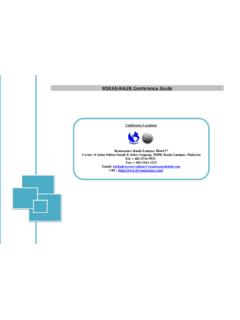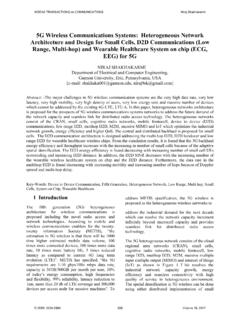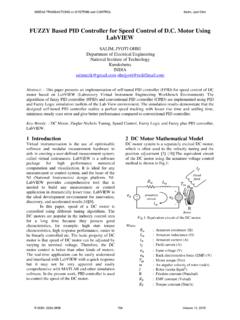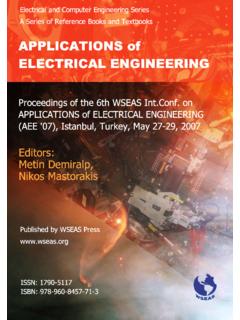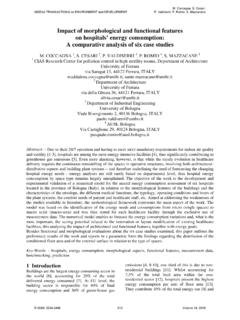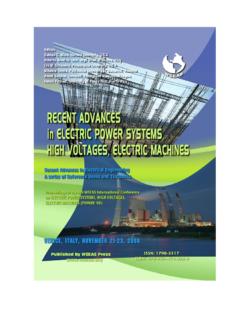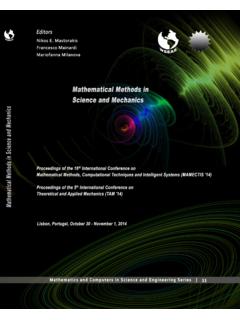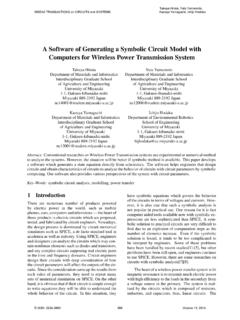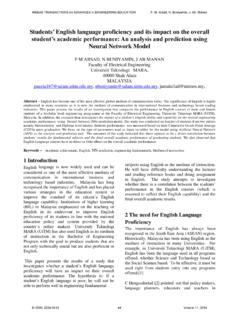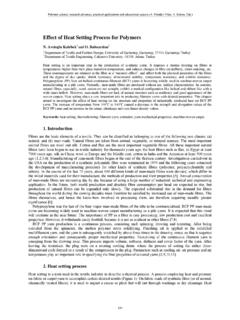Transcription of Effects of Environmental Factors in Transformer’s ...
1 Effects of Environmental Factors in Transformer s Insulation Life 1 Faculty, Department of Electrical and Electronics Engineering, Velalar College of Engineering and Technology, Thindal, Erode &12, Tamilnadu, INDIA. 2 Dean, College of Technology, Tiruchengode, Tamilnadu, INDIA. Abstract: The Hot Spot Temperature (HST) value depends on the ambient temperature, the rise in the top oil temperature (TOT) over the ambient temperature, and the rise in the winding HST over the top oil temperature.
2 In this paper a new semi&physical model comprising of the Environmental variables for the estimation of HST in transformer is proposed and also MATLAB/Simulink&based valid model of hot spot temperature under variable Environmental condition is proposed. The winding hot&spot temperature can be calculated as a function of the top&oil temperature that can be estimated using the transformer loading data, top oil temperature lagged regressor value, ambient temperature, wind velocity and solar heat radiation effect.
3 The estimated HST is compared with measured data of a power transformer in operation. The proposed model has been validated using real data gathered from a 100 MVA power transformer Key Words: Top Oil Temperature & Hot Spot Temperature Environmental variables 1 Introduction Power transformers are the main components and constitute a large portion of capital investment. When a power transformer fails, an adverse effect occurs in the operation of transmission and distribution networks resulting in increase of the power system operation cost and decrease of reliability in electricity delivery.
4 A prospective the transformer designer employs detailed electrical models to develop reliable and cost effective transformer insulation. Transformer aging can be evaluated using the HST. The increase in TOT and there by increase in HST has the effect of reducing insulation life [1&4]. Abnormal conditions, such as overloading, supplying non&sinusoidal loads or exposure to higher ambient temperature than normal, can accelerate transformer aging and accordingly accelerate the time to end of life.
5 The increase in TOT and HST accelerates the end of the transformer lifetime. The average lifetime of oil&immersed a transformer based on the lifetime of the solid insulation is well defined in [5], in which the average lifetimes based on different end of life criteria are summarized. The load on a transformer cannot be increased indefinitely without causing premature aging of transformer s insulation. Aging or deterioration of insulation is a time&function of temperature, moisture content, and oxygen content.
6 The moisture and oxygen contributions to insulation deterioration can be minimized with modern oil preservation systems, leaving insulation temperature as the primary parameter. The primary contributor to insulation temperature is the heat generated by load losses. Since the deterioration in the insulation is related to the insulation temperature and the temperature distribution due to load losses is not uniform in the windings in most cases, it is reasonable to believe that the greatest deterioration to the insulation will happen at the part of the winding operating under the highest temperature condition.
7 Therefore, in aging studies it is usual to consider the aging Effects caused by the HST. The variation of power transformer loading beyond nameplate rating in both normal and emergency cases increases temperature inside the transformer tank and may causes the rapid thermal deterioration of the insulation [6]. This is a cause of transformer failure. In order to make the power transformers in terminal stations operate at their full WSEAS TRANSACTIONS on POWER SYSTEMSM. Srinivasan, A. KrishnanE-ISSN: 2224-350X35 Issue 1, Volume 8, January 2013capacity without failures due to temperature increase at the same time, a careful study of their entire thermal behaviour is needed.
8 The standard normal lifetime for oil&immersed power transformer for a continuous HST of 110oC based on [1] and other IEEE standards. There are two approaches to deal with HST: to measure it or to calculate it. Measuring the HST imposes unwanted costs to the system. For this reason, several models for prediction of HST have been presented in the literature [7]. Since the thermal phenomena are quite complex, it is not easy to consider all the details in the thermal model precisely. There are some simplified thermal models in the appropriate standards such as IEEE which have limited accuracy.
9 The commonly used model is described in clause 7 in the IEEE loading guide [1]. The top oil rise equation of clause 7 of the IEEE guide is modified to allow for continuously varying ambient temperature [8]. An alternative method is suggested in Annexure G. The method requires the use of bottom oil rise over ambient at rated conditions. The duct oil temperature is introduced which may be higher than the top oil temperature under certain conditions [3]. Also this model requires more test parameters for calculating HST.
10 The prediction of HST compared with measured HST, the error is most likely due to insufficient driving variable data rather than an inaccurate or insufficient model [9]. In this paper, we report on the results of several attempts to improve the model used for predicting transformer HST. The result of this research lends additional support to the hypothesis that accurate prediction of transformer HST is due to noise in the input data and the absence of measurements for significant driving variables.
